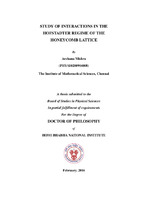- DSpace Home
- →
- IMSc Theses/ Dissertations
- →
- IMSc Theses/ Dissertations
- →
- View Item
JavaScript is disabled for your browser. Some features of this site may not work without it.
| dc.contributor.author | Archana Mishra | |
| dc.date.accessioned | 2016-08-30T07:14:55Z | |
| dc.date.available | 2016-08-30T07:14:55Z | |
| dc.date.issued | 2016 | |
| dc.date.submitted | 2016 | |
| dc.identifier.uri | https://dspace.imsc.res.in/xmlui/handle/123456789/383 | |
| dc.description.abstract | The recent realization of Hofstadter butterfly in moire superlattices and realization of the Hofstadter Hamiltonian in the square lattice in cold atom systems has motivated me to study the effect of interactions in the Hofstadter regime of the honeycomb lattice. My main aim in this work is to understand the interaction induced complex phases in detail and study the topology and geometry of the ground state of the system. Interactions induces charge ordering which break the translational and rotational symmetry of the system giving rise to anisotropic phases as the ground state for this system. The anisotropy in the particle density can be characterized by quadrupole and dipole moments and the phases are accordingly classified to symmetric phase, charge density wave, nematic phase and ferrielectric phase. Some of these Landau phase transitions are accompanied with the change in the topology of the system thus giving examples of topological transitions from non-zero Hall conductivity phase to zero Hall conductivity phase. I try and give an insight to these topological transitions. Throughout the range of interaction strength considered, the energy gap never closes and hence the mean field approximation is an good approximation here. Further, I also study the geometry of the ground states and investigate the structure of the anisotropic phases by studying pair correlations from the point of view of the quantum geometric approach to insulating states. I extended the above framework to include the magnetic flux per plaquette of the form p/q where p,q are coprime integers and p < q. I consider q ∈ [3, 20] and solve the interacting Hamiltonian using mean field theory for filled band cases and main aim of this work is to study the effect of interactions on the Hofstadter butterfly. By studying the energy flux diagram and the Landau fan diagram, I see that the fractal structure in the Hofstadter butterfly gets more and more disintegrated with the increase in the interaction strength. As the interaction strength increases, the number of phase transitions to translational symmetry breaking phases increases. This breaking of translational symmetry introduces a new length scale in the system which leads to the disintegration of the fractal nature of the energy flux diagram. Many of these phase transitions are accompanied with the change in the Hall conductivity of the system. These topological transitions also increase with the increase in the interaction strength and hence, the disintegration of the Hofstadter butterfly gets manifested in the Landau fan diagram. I also propose a method to probe the Berry curvature in the optical lattice system. The confining trap breaks particle-hole symmetry and makes the Berry curvatures of the bands observable. I have shown that the effect of this is seen in the rotation of the expanding cloud when the trap is removed. For realistic atomic and trap parameters, I have shown that this provides a clear signal in time-of-flight experiments. | en_US |
| dc.publisher.publisher | The Institute of Mathematical Sciences | |
| dc.subject | Honeycomb Lattice | en_US |
| dc.subject | Hofstadter Regime | en_US |
| dc.subject | HBNI Th96 | en_US |
| dc.title | Study of interactions in the Hofstadter regime of the honeycomb lattice[HBNI Th96] | en_US |
| dc.type.degree | Ph.D | en_US |
| dc.type.institution | HBNI | en_US |
| dc.description.advisor | Syed R. Hassan | |
| dc.description.pages | 109p. | en_US |
| dc.type.mainsub | Physics | en_US |
| dc.type.hbnibos | Physical Sciences |
Files in this item
This item appears in the following Collection(s)
-
IMSc Theses/ Dissertations
IMSc Theses/ Dissertations
